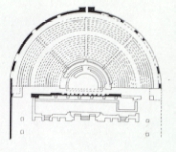Casino
Date Visited: 13 Nov 1999
Karina's Documentation

Plan from Teatri Greci e Romani
Post-dates TP (early Augustan?) Coarelli suggests
a date of about 40 BC. (Karina writes: For early date
and comparison with the Theatre of Pompey in Rome, as well
as to other theatres, see: F. Coarelli Varrone e il teatro
di Casinum in KTEMA Civilisations de L'Orient,
de la Grece et de Rome Antiques No.17, 1992, p.87 ff.)
2nd phase of scaena frons, including fossa and 'pole-holes,'by
Ummidia Quadratilla early 2nd century A.D. (d.108AD, based
on inscription, and an account by Pliny).
More detailed information on scaenae frons to come
from on-location archaeologist, Sacco Dante.


Porticus post scaenam = c. same depth & width
as from front of stage to rear of scaena frons, or
longer.

Modern quasi-opus incertum restoration of cavea
seating - i.e. not authentic.

Cryptogalleria summa cavea, and open porticus (and
sacellum facade?) above.

Opus reticolatum on interior of cryptogalleria
and exterior of cavea.
Various entrances into cavea from cryptogalleria.


Various entrances from behind cavea into cavea, including
ramp-based access, including possible entrance under possible
sacellum at 'apex' of cavea.
Possible sacellum at 'apex' of cavea, possibly raised above
porticus summa cavea.
Fragments of various statues from theatre, including possible
Varro, now in Naples, and possible Augustan family.

Sacco Dante
Receive photocopies of materials, cc. of archival photos,
and hypotheses re. scaenarum frontes (his speciality) in
return for use of images of our model.
SD will try to find original reconstructions also (by SD's
uncle).
(Karina writes: In the meantime, I have got the material
from Dante, but I think we already got the photos we wanted
when were were there. I send it on with the other
material still needed to be photocopied.)
Warning: Reconstruction by SD's uncle shows a very TP-like
sacellum facade summa porticus, BUT this reconstruction
may itself be based on TP, so check archaeological data
before using as evidence of TP's influence.
Notes from Teatri Greci e Romani
Cassino
Casinum
Regio I, Latium et Campania
G.R.Bellini
Roman theatre. Urban, close to the amphitheatre
(about 150 m. away). It is built beyond the line
of the walls on the eastern side. Facing south-west.
The building dates to the Augustan period. Restorations
were carried out in the following century (possibly by
Ummidia Quadratilla).
The theatre rests on a natural slope. The cavea
is divided into two maeniana by a corridor. Each
maenianum is split up by flights of steps into
four cunei. The upper maenianum was crowned
by a gellery in summa cavea decorated with Corinthian
semicolumns. The cavea was separated from the orchestra
by a marble balustrade. Access to the orchestra
was through lateral corridors covered by vaults.
The scaena is preserved at foundation level. Three
doors opened onto the rear wall. Only the central
door could be seen from the cavea. The two lateral
ones were probably used as utility doors. The pulpitum
was decorated with a series of plastered rectangular and
semi circular niches. Behind the frons pulpiti,
a narrow corridor was created to control the aulaeum,
which was supported by wooden scaffolding housed in small
square (preserved) openings in the floor. The hoisting
apparatus was however located in a room at the north-western
end of the corridor used to control the aulaeum.
The structures are faced in limestone opus reticolatum,
which in certain points is multicoloured (light limestone
cubilia alternating with dark tufa cubilia).
The toothing is partly in small limestone blocks and partly
in opus latericium.
Following the construction of the theatre, a tank was
put up in the north-western corner of an ambulatory perpendicular
to the western parodos. The tank may have
been used to feed water to a fountain, but it was in any
case used to collect rainwater exploiting a system of
canals.
State of preservation:
the theatre underwent restoration in 1936 (when it was
freed from overlying modern structures), and more recently,
when the tiers of steps were reconstructed.
Measurements:
diameter of the cavea: 54 m.
Original capacity:
about 2,000 seats.
Current utilisation of the theatre:
it is used for theatrical performances.
Current capacity:
about 2,000 seats.
Bibliography
G. ROFNI 1970, s.v. Teatro
G.F.CARETTONI, Casinum, Roma 1938, p.83 ss.
FABBRINI (?) (illeg. from our photocopy) . . . Centro
Studi Internazionalie G. Ermini, Ferentino-Cassino,
1991, in corso di stampa.
M.FUCHS 1987, p.22 22.
C.COURTOIS 1989, pp.115-118:215-216.
